Available Languages
- Consultez cette page en FRANÇAIS
- Consult this page in ENGLISH
The Semantic Graph
1. Abstract
Rastier
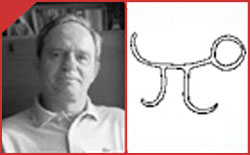
A device proposed by Rastier (and based on Sowa, 1984), the semantic graph can be used to represent any semantic structure, that is, the semes and the relationships between them. The semes are the nodes of the semantic graph (shown in boxes or brackets) and the relationships are the links (shown in ellipses or parentheses). The arrows indicate the direction of the relationship between nodes. We can describe most semantic structures using a dozen or so different links - like ERG (ergative) for the agent of an action and ACC (accusative) for the patient of an action. Here is an example of a simple graph: [Prince] ← (ERG) ← [RESCUE] → (ACC) → [Princess].
This text can be found in extended version in this book:
Louis Hébert, Dispositifs pour l'analyse des textes et des images, Limoges, Presses de l'Université de Limoges, 2007.
Click here to obtain the English translation of this book.
This text may be reproduced for non-commercial purposes, provided the complete reference is given:
Louis Hébert (2006), « The Semantic Graph » with Lucie Arsenault’s collaboration, in Louis Hébert (dir.), Signo [online], Rimouski (Quebec), http://www.signosemio.com/rastier/semantic-graph.asp.
An updated and extended version of this chapter can be found in Louis Hébert, An Introduction to Applied Semiotics: Tools for Text and Image Analysis (Routledge, 2019, www.routledge.com/9780367351120).
2. THEORY
2.1 FUNCTION
Rastier's semantic graphs (cf. Rastier, 1997 [1989] and Hébert, 2000), which are based on Sowa's conceptual graphs (1984) can be used to make a formal, rigorous, comprehensive and elegant representation of any semantic structure: a word, a whole text, a topos (an argumentative or narrative cliché), a character, an action, etc.
2.2 ELEMENTS
The elements that compose this structure are the nodes (the terms), the links (the relationships) and the direction of the links. A node is generally labelled with one or more semes (semantic features, or parts of a signified) and a link with a semantic case (or case, for short). Often a node corresponding to a process is placed at the centre of the graph (labelled by either a verb or a noun, such as transmit or transmission) and it is often written in the upper case.
Here is a simple graph shown in text format (later we will give a graph in strictly graphical format), where (ERG) corresponds to the ergative case (the agent of an action) and (ACC) to the accusative case (the patient of an action, the one affected by it):
[dog] ← (ERG) ← [BITE] → (ACC) → [mailman]
2.2.1 THE LINKS
The following semantic cases can adequately account for most semantic structures:
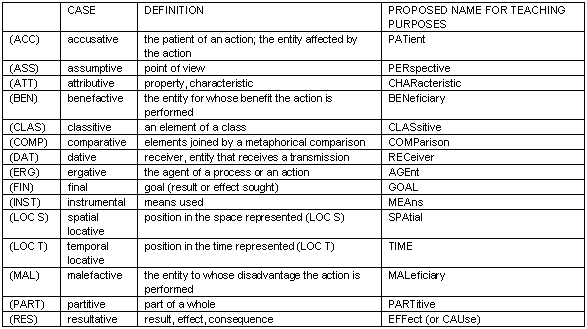
NOTE: CHANGES TO RASTIER'S LIST OF THE PRIMARY CASES
We have modified the inventory of primary cases that Rastier established (1989). We are distinguishing the temporal locative from the spatial locative with different abbreviations (both of which were labelled (LOC) by Rastier). We are adding the assumptive, the malefactive, the classitive (for set relations, as in [dog] → (CLAS) → [mammal]) and the partitive (PART) for mereological relations, as in [word] → (PART) → [sentence]).
2.2.2 THE ARROWS
The nodes and links are joined by arrows (or lines with arrows) indicating the direction of the relationship. The table shows the direction of the arrows in the simplest graphs and is based on the directions Sowa used (1984).
The direction of the arrows in the graphs
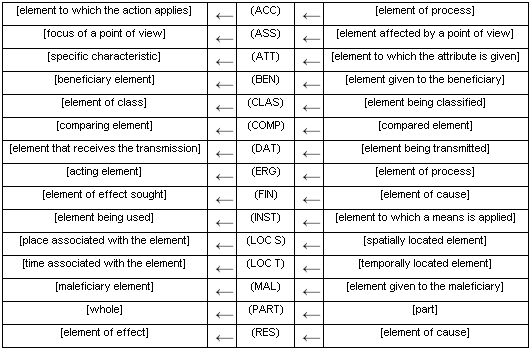
For the sake of uniformity, horizontal arrows pointing to the left were used in this table, which dictated the relative positions of the nodes. As we will see in our examples of graphs, in practice, the arrows in a given graph can also point to the right (for instance, [element of process] → (ACC) → [element to which the action applies]) or vertically (up or down). Rather than following Sowa's rules, we can orient the arrows "intuitively" (for example: [man] → (ERG) → [LOVE] → (ACC) → [woman] ← [brilliant]), or even replace them with lines that don't have arrows if there is no possible ambiguity in the direction of the link. It is also permissible to draw a link with only one arrow on its trajectory rather than two, as we have done in our strictly graphical-format examples).
2.3 A GRAPH TO ILLUSTRATE THE PRIMARY CASES
We will give an example to illustrate the primary cases, simplifying both our analysis and its representation: "According to John, yesterday, right here, Peter - a generous sort - gave Mary a doll and a cup-and-ball game so that she would have fun with these presents; but instead she cried like a geyser." We are using the opposition true/false to show the distance separating the intention (Mary as beneficiary) from the result (Mary as maleficiary).
A graph to illustrate the primary cases
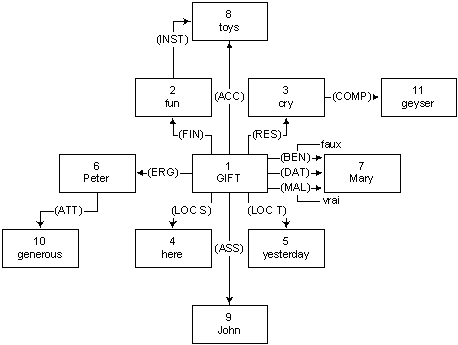
3. APPLICATION: THE TOPOS OF THE SCORNED POET
We will examine a topos (a common-place, or narrative cliché) that is very pervasive in French poetry: the misunderstood poet.
The graph we propose is a generalized one representing the topos of the scorned poet: In it, the poet becomes an exceptional individual, and his poetry a positive transmission to the collective group. With this generalized representation, we can see the cross-disciplinary nature of the topos, which applies not only to its occurrences in literature, but also religion (the Bible), philosophy (Plato), etc. The graph may be verbalized as follows: An (3) exceptional individual, who is part of (1) a superior world, effects (5) a positive transmission (an exceptional work of poetry, for instance) to (4) the collective group, which belongs to (2) an inferior world; but in return, the collective group sends a (6) negative transmission (for example, by revealing its scorn for the work of poetry).
A generalized graph of the topos of the misunderstood poet
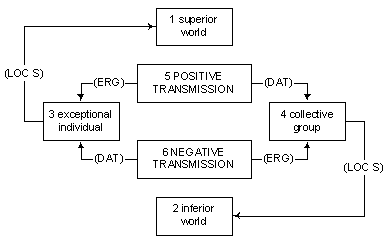
The following are a few manifestations that exemplify this topos:
A. Plato, the Myth of the Cave (The Republic). 1. The world of ultimate reality (ideality). 2. The world of illusion. 3. The man who gains access to ultimate reality. 4. Mankind, enslaved to illusion. 5. The exceptional man tries to liberate his fellows, as he liberated himself. 6. Rejection; they don't believe him; they think he is crazy.
B. Plato. 1. The world of understanding. 2. The world of ignorance. 3. Socrates. 4. Socrates' accusers. 5. Socratic understanding. 6. The punishment: drinking hemlock. This transmission is object-related (pragmatic, and not solely cognitive, as is often the case).
C. The New Testament 1. The spiritual world. 2. The material world. 3. Jesus. 4. Mankind. 5. Christ gives his life out of love for mankind. 6. Rejection by the majority (for example, Barabbas is preferred over Jesus), with some exceptions: Palm Sunday, the good will of the disciples, the "enlightened few" (except for some denials)...
D. Victor Hugo, "The Poet's Function". Sunbeams and Shadows (March 25-April 1, 1839). 1. The world to come. 2. The world as it is. 3. The poet (lexicalized as "singer", "prophet", etc.). 4. "Brothers", "city". 5. The poet is tempted to escape from the city and merge with nature (the secularization of the spiritual world), and like Christ, tempted to shrink from his duty, but "Alas! Duty calls each of us to the others!" and moreover, the poet-prophet has a higher responsibility. 6. The poet fulfills his role, whether he is insulted or praised. However, the rejection may be in appearance only: "many a false prophet at his words / Laughs aloud and reflects silently". (The false prophet introduces the theme of the mediocre poet, as well as the theme of the usurper).
E. Baudelaire, "The Albatross", The Flowers of Evil (1857). 1. The poetic world (compared element) / the aerial world (comparing element). 2. The prosaic world / the non-aerial world. 3. The poet / the albatross. 4. The masses / the sailors. 5. Positive transmission or autonomy, withdrawal of the poet-albatross (a Parnassian position)? Here the metaphor doesn't fly, it seems, since the albatross transmits nothing positive to the sailors, except his beauty in flight. 6. Jeers. In the aerial-poetic world, the albatross-poet can simply launch attacks on the inhabitants of lower worlds: He "haunts the storm and laughs at the archer".
F. Uderzo and Gosciny, the comic strip Astérix. 1. The poetic world. 2. The prosaic world. 3. The bard. 4. The masses. 5. He bestows his art generously. 6. Harassment. In this case, the topos is reversed; the poet has no talent and everyone is right to scorn him. This rejection of poets in general or a poet in particular may also be expressed by a poet, which is exactly what happens in "To an Ignorant Poet" by Marot. And Cendrars (Prose of the Trans-Siberian) criticizes a poet as well, who is none other than himself, perhaps just in days gone by: "Anyway, I was a really bad poet".
4. LIST OF WORKS CITED
- HÉBERT, L., "Analyse et représentation des topoï", Tangence, Rimouski/Trois-Rivières: UQAR/UQTR, 64, Autumn, 2000, p. 25-48.
- RASTIER, F., Meaning and Textuality, trans. Frank Collins and Paul Perron, Toronto: University of Toronto Press, 1997 [1989].
- SOWA, J., Conceptual Structures, Reading (Massachusetts): Addison-Wesley, 1984.
5. EXERCISES
A. Make a semantic graph that portrays the following sentence:
At three o'clock, on the rug, Paul is eating heavy food, after which he falls asleep.
For this exercise, you will need the links (LOC T), (LOC S), (ATT), (ERG), (ACC), and (RES). Place the action [EAT] in the centre of the graph, and then place the other nodes in brackets.
B. Make a graph that portrays the following story:
In Quebec, on a December day at 7:52 p.m., Pierre is in his room caressing Marie... so very slowly... a delicious sort of Chinese water torture. A healthy child is born nine months later.

